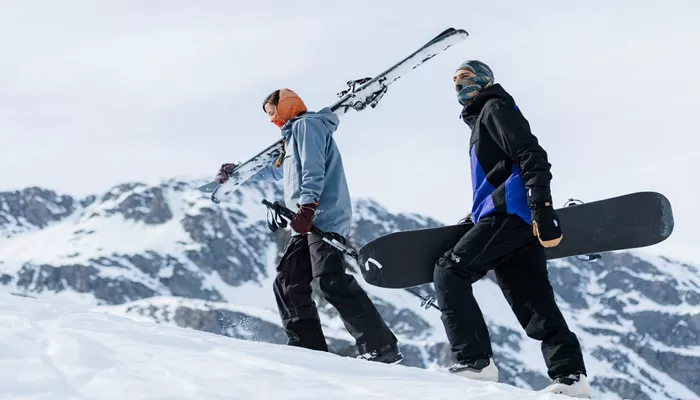Snowboarding is an exhilarating winter sport that has captured the hearts of many adventure-seekers worldwide. Its popularity stems from the thrill of speeding down snow-covered slopes, performing daring tricks, and experiencing the rush of adrenaline that comes with navigating challenging terrains. However, like any extreme sport, snowboarding comes with its set of challenges and risks. For beginners and seasoned riders alike, understanding these cons is crucial for enhancing safety and enjoyment on the slopes.
What Are the Cons of Snowboarding?
Complex Learning Curve
One of the most significant cons of snowboarding is its steep initial learning curve. Unlike skiing, where each leg can be controlled independently, snowboarding requires a rider to balance on a single board, moving sideways down the mountain.
This sideways stance can feel less intuitive for many beginners, making it more difficult to learn basic movements like turning and stopping. The process of mastering these skills can be frustrating and time-consuming, often leading to a higher number of falls during the initial stages.
However, once the basics are grasped, snowboarding can offer a faster progression in skill levels compared to skiing.
Experienced snowboarders often find that their ability to adapt to different terrains and conditions improves significantly over time, allowing them to tackle more challenging slopes with confidence.
Upper Body Injuries
Snowboarding poses a higher risk of upper body injuries compared to skiing. This is primarily due to the way snowboarders fall. When losing balance, snowboarders often use their arms to break their fall, which can lead to injuries in the wrists, shoulders, and collarbone. Common injuries include acromio-clavicular separations, clavicle fractures, rotator cuff strains, and humerus fractures. These injuries are not only painful but can also require significant recovery time, potentially sidelining a rider for several weeks or even months.
To mitigate these risks, it’s essential for snowboarders to learn proper falling techniques. This includes crouching down to reduce the impact on the upper body and rolling into the fall to distribute the force more evenly across the body.
Tailbone and Lower Body Injuries
In addition to upper body injuries, snowboarding also poses risks to the tailbone and lower body. Beginners often fall on their backsides, which can lead to tailbone injuries. These injuries, while typically not as severe as upper body fractures, can still be painful and may require some time to heal.
Furthermore, the repetitive stress on the knees and ankles from landing jumps or absorbing impacts can lead to long-term wear and tear. This highlights the importance of wearing proper protective gear, such as helmets and knee pads, and ensuring that boots fit well to provide adequate support.
Challenges with Ski Lifts
Another con of snowboarding is the difficulty associated with using ski lifts. Unlike skiers, who can easily step off their skis and walk onto a lift, snowboarders must remain strapped into their boards. This means they have to sit down on the chairlift with their board attached, which can be awkward and sometimes challenging, especially for beginners.
Additionally, getting on and off lifts requires a bit of practice, as snowboarders need to position themselves correctly to avoid falling or losing control of their board.
Speed Control in Flat Areas
Snowboarding in flat areas can be particularly challenging for beginners. Unlike skiing, where poles can be used to help propel through flat sections, snowboarders must maintain their speed to keep moving. If speed is lost, it can be difficult to regain momentum without poles, leading to frustration and a higher risk of falls.
This challenge emphasizes the importance of learning how to control speed effectively. Techniques such as shifting weight and using the edges of the board can help manage speed, but mastering these skills takes time and practice.
Weather and Terrain Risks
Snowboarding, like skiing, involves navigating through varied and sometimes unpredictable terrains and weather conditions. Risks include avalanches, exposed rocks or ice, trees, and other natural obstacles that can pose significant hazards. Additionally, changing weather conditions can quickly alter the safety of the slopes, making it essential for snowboarders to stay informed about weather forecasts and slope conditions.
Staying within designated areas and following safety guidelines is crucial to minimize these risks. Snowboarders should always be aware of their surroundings and adjust their riding style according to the conditions.
Physical Conditioning and Safety Equipment
Engaging in snowboarding requires a good level of physical fitness.
The sport demands strength, flexibility, and endurance, particularly in the legs and core. Without proper conditioning, riders may tire quickly, increasing the risk of accidents due to fatigue.
Moreover, wearing appropriate safety gear is vital. This includes helmets, knee pads, and well-fitting boots. Proper equipment not only protects against injuries but also enhances performance by providing better support and stability.
Conclusion
While snowboarding comes with several cons, including a steep learning curve, risk of injuries, and challenges with ski lifts and speed control, it remains a highly rewarding sport for those who persevere. The thrill of gliding down a mountain, the camaraderie among snowboarders, and the sense of accomplishment from mastering new skills make it an experience unlike any other.
To enjoy snowboarding safely and effectively, it’s crucial to be aware of these challenges and take steps to mitigate them.
This includes learning proper techniques, staying physically fit, using appropriate safety gear, and being mindful of weather and terrain conditions. By understanding and addressing these cons, snowboarders can maximize their enjoyment of the sport while minimizing risks.

